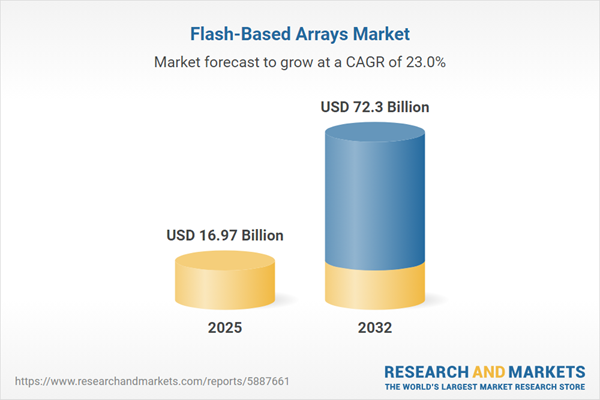Speak directly to the analyst to clarify any post sales queries you may have.
Flash-based arrays are reshaping enterprise data storage with solutions that deliver secure, agile, and adaptable environments for large organizations. These platforms address increasingly complex operational and compliance requirements, allowing senior leaders to position their IT infrastructure for future resilience and innovation.
Market Snapshot: Flash-Based Arrays
The flash-based arrays market is demonstrating strong momentum, projected to reach USD 16.97 billion by 2025 from USD 13.82 billion in 2024, marking a CAGR of 22.97%. This growth is anchored by rapid digital transformation initiatives, escalating data volumes, and continuous investments in storage modernization across primary sectors. Financial services, healthcare, government agencies, and technology firms are at the forefront, integrating flash arrays to bolster analytics, uphold business continuity, and support cloud migration. Demand is driven by the need for infrastructure that adapts alongside strategic changes and regulatory evolutions, firmly establishing flash-based storage as a catalyst for competitive differentiation.
Scope & Segmentation: Flash-Based Arrays Market
- Array Types: All Flash Arrays and Hybrid Flash Arrays are adopted to fulfill a spectrum of performance, scaling, and workload optimization requirements. Their managed storage features and automated tiering enable seamless operation under varied enterprise conditions.
- Deployment Models: Cloud-based, hybrid, public, private, multi-cloud, and on-premises implementations are prevalent. Enterprises leverage vendors and platforms such as AWS, OpenStack, VMware, Microsoft Azure, and Google Cloud for integration flexibility and to support both centralized and distributed data centers.
- End User Industries: Key sectors include banking, insurance, healthcare, IT, telecommunications, and government. The emphasis in these segments is on compliance, operational sustainability, and minimizing risk while maximizing efficiency through advanced data capabilities.
- Applications: Organizations deploy flash-based arrays for artificial intelligence, machine learning, analytics (real-time and batch), transactional processing, and virtualization. These applications ensure consistent availability and allow rapid scalability to adapt to evolving business strategies.
- Interface Technologies: NVMe, SAS, and SATA are central to enabling low-latency, high-throughput connectivity. These technologies help enterprises tackle demanding and variable IT workloads, supporting both existing operations and anticipated future needs.
- Regions: Adoption patterns vary across the Americas, Europe, the Middle East, Africa, and Asia-Pacific. Market drivers include local regulatory policies, distinct funding mechanisms, and unique modernization goals, affecting procurement and technology deployment strategies.
- Key Companies: Leading providers, including Dell Technologies, Pure Storage, NetApp, Hewlett Packard Enterprise, IBM, Hitachi Vantara, Huawei, Fujitsu, Infinidat, and Kaminario, set industry direction with portfolios that address sector-specific and evolving enterprise demands.
Key Takeaways for Senior Decision-Makers
- Flash-based arrays deliver fast, agile data processing to power business-critical operations across local and global environments.
- Automation within these platforms reduces the manual burden on IT staff, promoting resource optimization and supporting more responsive operations in hybrid and cloud deployments.
- Modular architectures enable infrastructure to grow with organizational needs, providing expansion options without adding operational complexity.
- Solution flexibility is essential for meeting diverse compliance standards and supporting effective risk management, especially across jurisdictions with complex regulatory expectations.
- Open standards and advanced control technologies deliver procurement agility, fostering customization and adaptability in enterprise deployments.
- The combination of artificial intelligence integration, edge computing, and hybrid cloud adoption positions flash-based arrays as vital for building robust and resilient infrastructure strategies.
Tariff Impact and Supply Chain Considerations
- Organizations are reassessing their supply chains and vendor partnerships in response to fluctuating tariffs, prioritizing continuity in sourcing flash memory components and minimizing potential disruptions.
- Manufacturers are investing in local production and diversified supplier ecosystems to strengthen supply chain resilience and enable more strategic, long-term investments in IT storage.
Methodology & Data Sources
This report consolidates findings from structured interviews with senior executives and field experts, cross-referenced against current regulatory requirements and leading industry literature. These methods establish a factual basis for actionable market analysis.
Why This Report Matters
- Enables technology and procurement decision-makers to align storage investments with both immediate operational needs and evolving strategic goals.
- Clarifies the market landscape, empowering IT planning and prioritization of modernization efforts in a competitive landscape.
- Delivers a balanced review of vendor offerings, supporting confident and streamlined management of the enterprise storage lifecycle.
Conclusion
Strategic adoption of flash-based arrays empowers enterprises to build adaptive, forward-looking digital infrastructure. These technologies equip organizations to respond to change while sustaining compliance and operational effectiveness in diverse regulatory environments.
Additional Product Information:
- Purchase of this report includes 1 year online access with quarterly updates.
- This report can be updated on request. Please contact our Customer Experience team using the Ask a Question widget on our website.
Table of Contents
3. Executive Summary
4. Market Overview
7. Cumulative Impact of Artificial Intelligence 2025
Companies Mentioned
The companies profiled in this Flash-Based Arrays market report include:- Dell Technologies Inc.
- Pure Storage, Inc.
- NetApp, Inc.
- Hewlett Packard Enterprise Company
- International Business Machines Corporation
- Hitachi Vantara Corporation
- Huawei Investment & Holding Co., Ltd.
- Fujitsu Limited
- Infinidat Ltd.
- Kaminario, Inc.
Table Information
| Report Attribute | Details |
|---|---|
| No. of Pages | 190 |
| Published | November 2025 |
| Forecast Period | 2025 - 2032 |
| Estimated Market Value ( USD | $ 16.97 Billion |
| Forecasted Market Value ( USD | $ 72.3 Billion |
| Compound Annual Growth Rate | 22.9% |
| Regions Covered | Global |
| No. of Companies Mentioned | 11 |









